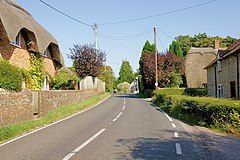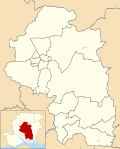Itchen Stoke and Ovington
 Cottages at Itchen Stoke | |
Location within Hampshire | |
| Population | 373 [1] 216 (2011 Census)[2] |
|---|---|
| OS grid reference | SU5594132397 |
| Civil parish |
|
| District | |
| Shire county | |
| Region | |
| Country | England |
| Sovereign state | United Kingdom |
| Post town | ALRESFORD |
| Postcode district | SO24 |
| Dialling code | 01962 |
| Police | Hampshire and Isle of Wight |
| Fire | Hampshire and Isle of Wight |
| Ambulance | South Central |
| UK Parliament | |
Itchen Stoke and Ovington (/ˈɒvɪŋtən/) is an English civil parish consisting of two adjoining villages in Hampshire, England, 2 miles (3.2 km) west of Alresford town centre in the valley of the River Itchen, 5 miles (8.0 km) north-east of Winchester, and 2 miles (3.2 km) south-east of Itchen Abbas.
Itchen Stoke
The village population is 210, including Abbotstone.[1] Its most notable building is the Church of St Mary, a redundant Anglican church built by the civil engineer and architect Henry Conybeare in 1856, now under the care of the Churches Conservation Trust. It is in an early French style, Grade II* listed and made of brown and grey rubble stone with limestone dressings.[3]
History
The manor of Itchen Stoke was granted to the Bishop of Winchester by King Edgar in 960.[4] The Domesday Book records the manor as having passed to Romsey Abbey, which retained it until the Dissolution of the Monasteries. It then passed to Sir William Paulet, later the first Marquess of Winchester and stayed with his family until the time of the Commonwealth. Itchen Stoke Mill (with an attached miller's cottage) is of ancient origin. The current building dates from the 18th century and straddles the mill race.[5] Itchen Stoke House is 19th century, has nine bays and is central with small grounds; this being the former rectory.[6]
Abbotstone
This outlying north-east hamlet of a few houses has a population of 32.[1][7] It was formerly in its own civil parish[7] and lies along the Ellisfield to Itchen Abbas portion of the Three Castles Path[8] Abbotstone contains an abandoned medieval village,[8] with further details at the charity English Heritage's website[9] and evidence of fortifications,[7] as well as several abandoned quarries.[7][10]
The traveller Celia Fiennes, who made extensive tours riding side-saddle, passed through "Aberstone" in 1691. She noticed the house of the Duke of Bolton "which stands on the side of a hill where are fine Gardens and much fruite."[11]
Ovington

The village on the opposite south bank, of the River Itchen, known upstream as the River Alre in New Alresford and Old Alresford, has a population of 163[1] and several homes, including an Old Rectory.[12] Its largest building in the central area is Ovington House, of no great antiquity, but its North Lodge is listed as Grade II.[13] There is a pub, the Bush Inn.
Its church is dedicated to St Peter and is Grade II listed.[14]

Extending to the far south into the South Downs National Park, the parish reaches a Scheduled ancient rectangular enclosure.[9]
History
The name appears in the Domesday Book as "Ofinetune", which means "the place above" in Old English.[15]
The revenues from the manor at Ovington supported Itchen's nuns until 1284 when it was sold to the monks of St. Swithun's Priory, Winchester Cathedral. On the Dissolution of the monasteries (1534–61), it was transferred to the newly formed Dean and Chapter of the cathedral. The manorial rights were disputed in 1855–59 between the Baroness van Zandt and the Bishop of Winchester. After this was resolved, it became the property of the Hewson family.[4]
The artist Fred Appleyard lived in Itchen Stoke. There is a major retrospective of his work in the Arc Winchester in Summer 2024, including many paintings from Itchen Stoke and Itchen valley.
References
- ^ a b c d "Census data". Archived from the original on 17 July 2012. Retrieved 4 June 2012.
- ^ "Civil Parish population 2011". Neighbourhood Statistics. Office for National Statistics. Retrieved 6 December 2016.
- ^ Historic England. "Details from listed building database (1095286)". National Heritage List for England. Retrieved 4 June 2012.
- ^ a b "Itchen Stoke and Ovington". Archived from the original on 21 August 2010. Retrieved 9 April 2011.
- ^ Historic England. "Details from listed building database (1095289)". National Heritage List for England. Retrieved 4 June 2012.
- ^ Historic England. "Details from listed building database (1095287)". National Heritage List for England. Retrieved 4 June 2012.
- ^ a b c d Page, William, ed. (1911) "Parishes: Itchen Stoke with Abbotstone" The Victoria History of the County of Hampshire and the Isle of Wight Constable, London, Vol. 4, pp. 192–95, OCLC 277849363
- ^ a b Leapman, Michael (26 September 1993) "Travel: In the footsteps of King John; Juggling route maps and rail timetables, Michael Leapman walks the Three Castles Path from Windsor to Winchester" The Independent London, Sunday Review section, p. 75.
- ^ a b Historic England. "Details from listed building database (1001803)". National Heritage List for England. Retrieved 4 June 2012.
- ^ "Hampshire County Council's legal record of public rights of way in Hampshire" (PDF). 2008. Retrieved 8 November 2010.
- ^ The Journeys of Celia Fiennes, ed. Christopher Morris (London: The Cresset Press, 1959).
- ^ Historic England. "Details from listed building database (1155202)". National Heritage List for England. Retrieved 4 June 2012.
- ^ Historic England. "Details from listed building database (1095294)". National Heritage List for England. Retrieved 4 June 2012.
- ^ Historic England. "Details from listed building database (1095292)". National Heritage List for England. Retrieved 4 June 2012.
- ^ "Article". Southern Life. Retrieved 4 June 2012.
External links
- A vision of Ovington @ visionofbritain.org
- Stained Glass Windows at St. Peter, Ovington, Hampshire
- Stained Glass Windows at St. Mary, Itchen Stoke, Hampshire
![]() Media related to Itchen Stoke and Ovington at Wikimedia Commons
Media related to Itchen Stoke and Ovington at Wikimedia Commons




